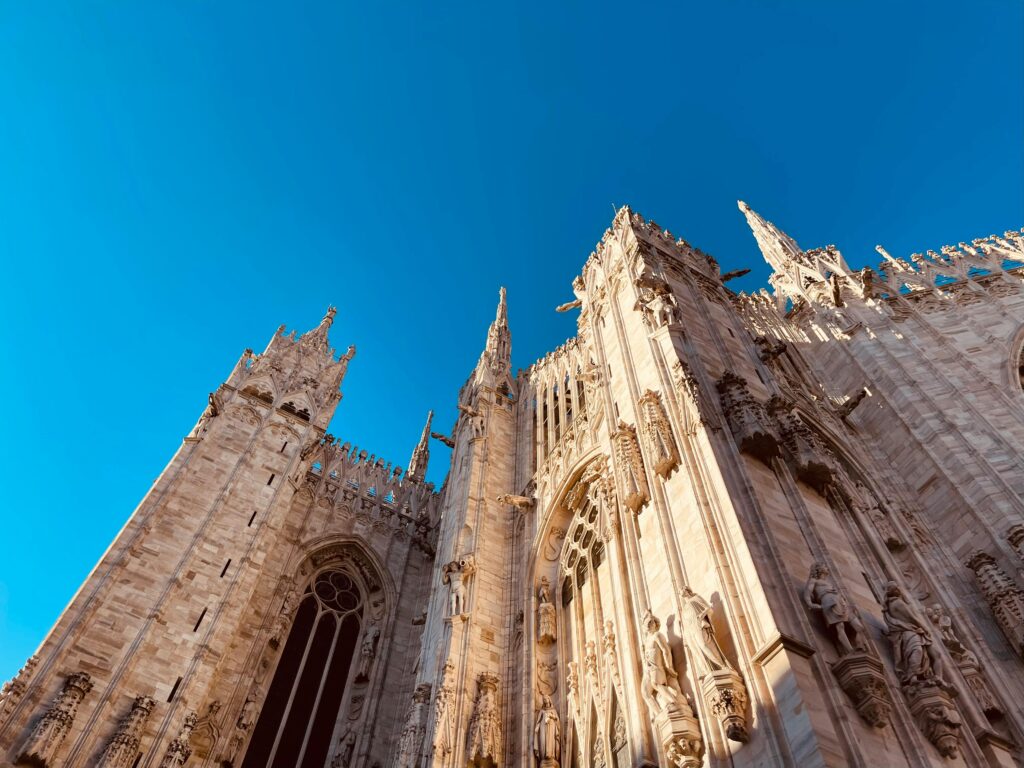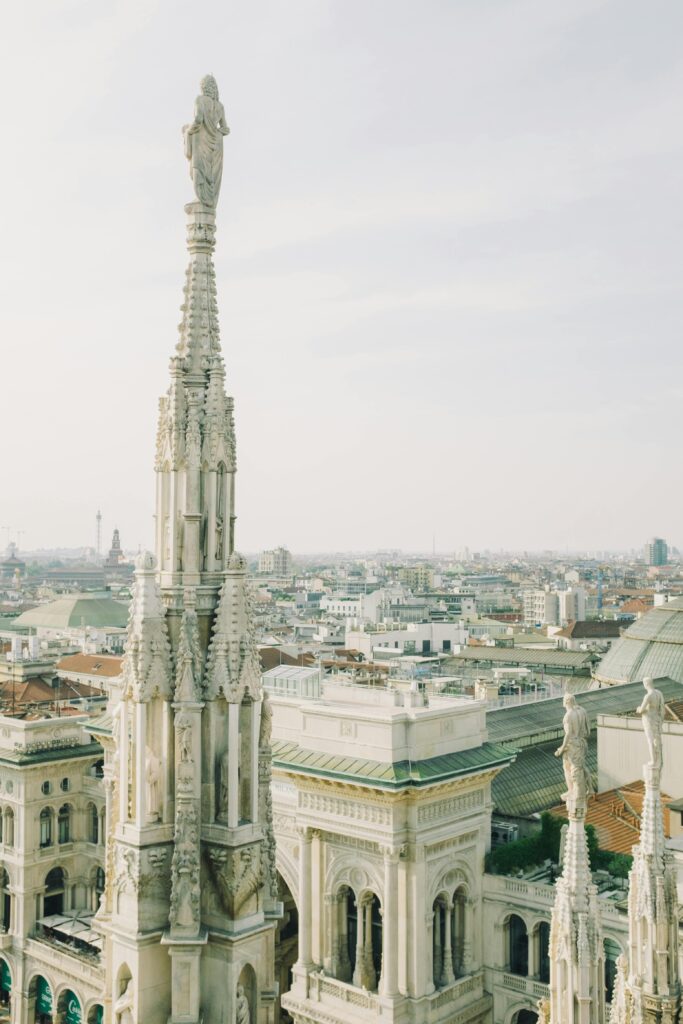One of the most popular routes for visitors to discover the city of Milan is the one that winds its way through the symbols of the city, which, starting from the Duomo, continues to the Castello Sforzesco, then with a walk through the fascinating Brera Art District, to reach Piazza della Scala where the famous temple of opera can be admired, and then concludes with the elegance of the Galleria Vittorio Emanuele, bringing visitors back close to the Duomo. We start, then, from the symbol par excellence of the Lombard capital, which encompasses six centuries of history and towers in all its beauty over the piazza of the same name.

Francesco Sgura on Pexels
Milan Cathedral: history and origins
Perhaps not everyone knows that the Duomo is a Marian cathedral, being dedicated to Santa Maria Nascente.
In terms of surface area, it is the fourth largest church in Europe, after St Peter’s in the Vatican, St Paul’s in London and Seville Cathedral.
Its construction began in 1386 on the area that was first the pagan temple of Minerva and then the episcopal complex of imperial Mediolanum. Mediolanum was the capital of the Western Roman Empire between the 3rd and 4th centuries AD and also became the capital of Christianity thanks to Bishop Ambrose, the city’s famous patron saint.
“A ufo” cathedral
In spite of the Lombard architectural experience using terracotta as a material, the new cathedral was built with a much nobler material: pinkish white marble from the quarries of Candoglia, a locality about 80 km north-west of Milan on Lake Maggiore, bordering Piedmont.
The Duke of Milan Gian Galeazzo Visconti bought the marble quarries, founded the Veneranda Fabbrica of Duomo and started the construction of the great cathedral, symbol of his power and Christian religiousness, giving it to the people of Milan
The marble blocks necessary for the construction of the Duomo arrived from Lake Maggiore by navigating the River Toce, the Ticino, the Naviglio Grande and the inner trench of the canals to the Laghetto, a small artificial basin dug between today’s Cà Granda and the church of Santo Stefano. This is the etymological origin of the expression ‘a ufo’, from the typical Lombard saying ‘auf’, meaning ‘free, without charge’. It refers precisely to the transporters of the marble blocks, who were exempt from paying duties: the vessels bore a large inscription ‘AUF – Ad Usum Fabricae‘ on the keel, and therefore sailed ‘ad ufo’, free of tolls. It was precisely for the transport of marble that the locks were built, a system to balance the difference in height between the water channels outside the walls of Mediolanum and the internal canals.

Martina Amaro on Pexels
The Lombard Gothic
Although Gothic in religious architecture originated in France, with the earliest examples dating back to the mid 1100s, it arrived in Milan more than a century later and expressed itself with more subdued characteristics: less impetuous structures and less expressive decorations than other international examples.
These peculiar characteristics are called Lombard Gothic.
In fact, the Milan Cathedral is defined as International Gothic due to its sculptural magnificence and is a unique monument in the broad panorama of Gothic cathedrals.
Local craftsmen were soon joined by sculptors, engineers and architects from Central European Gothic, thus making Milan, for more than two decades, a hotbed of talent. Such different skills, experiences and manual skills gave life to the international Gothic detail of the Duomo, which started from a European model, but then developed into a unique style, thanks to the heterogeneity of the workers involved.
The Veneranda Fabbrica of Duomo
In 1387, the Veneranda Fabbrica of Duomo was founded to organize the architectural logistics of the cathedral and to take care of the arrival of the Candoglia marble.
Since the beginning of the 1960s, the Veneranda Fabbrica has undertaken the methodical conservative restoration of the entire Duomo: the main spire, spires, vaults, cleaned façade, stained glass windows and paintings, gargoyles, flying buttresses, falconry, vertical structures of the flanks and apse with their set of thousands of statues, ornaments, high reliefs.
As one can imagine, the heritage resulting from this work is immense: thousands of statues (3419, of which 1100 inside, 2319 outside), myriads of half-length sculptures in the cornices and windows, spectacular stained-glass windows and ornate decorations.
A conservation work destined to continue over time with a great commitment of men, professionalism, increasingly up-to-date techniques and financial means.
The Cathedral: structure and architecture
The grandiose cathedral, with a capacity of about 40,000 people, has a Latin cross plan with five naves (the central nave is higher than the side naves) created by 52 pillars, 24 meters high and 3.5 meters in diameter, supporting the original Gothic cross vaults. It must have looked truly enormous in a Milan that went just beyond the current Cerchia dei Navigli (Navigli circle) and where houses reached a maximum of three or four storeys.
Spires (135), stained glass windows (164), statues and sculptures (3419) make it look almost ‘lace-like’.
And then there are the terraces, a splendid complex above the naves, which today can be accessed by lifts or a staircase with steps, to enjoy the view over the city.
In the second half of the 16th century, following the Council of Trento, the architectural order of the Cathedral was modified according to the new dictates of the Counter-Reformation strongly desired by the great archbishop Carlo Borromeo.
Thus were born: the new presbytery reconsecrated in 1577, consisting of the wooden choir (for the canons) and the senatorial choir (for the lay authorities), the large organs and side altars, as well as the marble floors. These were made of white and pink marble from Candoglia, black marble from Varenna (Lake Lariano, Lecco) and Swiss red marble from Arzo, now replaced by red stone from Verona.
At this time all the arts were in full swing, with a succession of craftsmen of every art and material (glass, stone, painting, metals, various decorators, as well as lute-makers and musicians), all from the Lombardy region and school.
Another decisive moment in the architectural realization of the cathedral and, in a certain sense, the conclusion of its decorative embellishment, occurred with Napoleon Bonaparte who arrived in Milan in 1796, choosing the city as the capital of his territories. To Napoleon’s will we owe: the completion of the façade and internal counter façade, the decorations on the ceilings of the aisles, much interior and exterior statuary, and many spires.
After his coronation in December 1804 at Notre Dame in Paris, Napoleon crowned himself in Milan, right in the cathedral, on 26 May 1805 celebrating the desired Kingdom of Italy, later never realized, with the Sacra Corona Ferrea, today kept in the treasure of Monza Cathedral.
The facade
This is the most recent part of the building and is divided into a mixture of styles: the upper part, above the first order of windows with a central balcony, is Napoleonic; while the lower part, with the five portals, is a complex of unique beauty created by the great artist Gian Battista Crespi known as Cerano, later chosen by Archbishop Federico Borromeo as the artistic director of the Ambrosiana in 1609; finally, the bronze doors are 20th century.
Two side statues can be admired on the balcony:
- the one on the left side represents the Law of Christ; its resemblance to the Statue of Liberty created by Bartholdi-Eiffel in 1885 makes it considered a source of inspiration
- the one on the right side represents the Old Law of Moses.
The exterior and doors
The cathedral was completed with several additions at the beginning of the 20th century, in particular changes to the doors.
The central one contains an intricate high-relief with Stories from the Life of Mary , of which the two central parts are particularly noteworthy: on the left Mary holds Jesus descending from the cross in her arms, on the right the Assumption of the Virgin Mary is narrated; while in the upper part of the central portal we have the Coronation of the Virgin. Each bronze door is decorated with a marble relief above the portal, here we see The Creation of Eve.
The other bronze doors depict
From the left:
- the first The affirmation of Christianity in Milan and the Edict of Constantine; in the frieze above Esther and Ahasuerus, biblical characters
- the second The Life of St. Ambrose; in the frieze above Sisara and Joel , biblical characters
- the first door to the right of the central one (in the 4th position) The affirmation of Milan as a free commune, then the history of Milan from the destruction of Barbarossa to the victory at Legnano; in the frieze above Judith cutting off Holofernes’ head, one of the biblical narratives most frequently reproduced in art
- the second door to the right The splendors of the Duomo, or episodes from the construction of the Duomo; in the frieze above King Solomon and the Queen of Sheba
The bas-reliefs near the doors represent stories from the Bible from the death of Assalomme to the Expulsion from Paradise.
The Terraces
The construction of the pedestrianized and panoramic terraces was arranged from the earliest years of the cathedral’s construction by the architects in order to enjoy the immense beauty between heaven and earth.
Today, in addition to the panorama that allows one to appreciate the bell tower of St Gotthard in the courtyard, the Rinascente, the central dome of the Galleria and, of course, the square, the view of the central tiburium and the Guglia Maggiore with the Madonnina is of high emotional impact.
The interior
The atmosphere inside the cathedral is particularly impressive considering the space, the little light and the religious significance: the spiritual rapprochement between the human being and God.
The underground spaces
Inside the cathedral you can admire two underground spaces of great beauty, the first, immediately at the entrance, is the archaeological area of the Baptistery of San Giovanni alle Fonti built by Ambrose in the 4th century to spread Christianity; the other, in the absidal area, consists of the Crypt with the Chapel of St. Charles, and the Iemale Chapel used for ecclesiastical investitures.
The Baptistery of San Giovanni alle Fonti
This is an octagonal building with a baptismal font with gushing water, fed by a brick conduit, commissioned by Bishop Ambrose in 386 where St Augustine was baptized by Ambrose himself.
Originally about 19.30 meters wide with four entrances opening into rectangular niches, with a pool of about 5 meters, it was destroyed in the 14th century to facilitate the construction of the cathedral.
The building was beautifully decorated with an opus sectile (stone slab) floor, which is still partially visible, and its visit is particularly significant from both a religious and archaeological point of view.
The octagonal perimeter of the baptistery is clearly visible today in the cathedral forecourt (above the steps, on the pavement). The shape recalls the symbolism of the number 8, the infinite number indicating eternal rebirth.
The crypt – scurolo and the Iemale Chapel
The crypt is circular in shape, with coloured marble, and was the place for the officiating canons and the custody of relics.
The ‘Scurolo‘ (so called from the Milanese dialect term scuroeu, i.e. a dimly lit or underground room) is the place where the remains of St Charles Borromeo are kept: a small octagonal chapel covered with silver leaf
The area communicated with the Treasury, which is now housed in the Duomo Museum.
The sundial
As soon as one enters the cathedral, one observes, embedded in the pavement and parallel to the façade, a brass strip embedded in the pavement that connects the right side with the left side and rises up the left wall for almost 24 meters, as well as white marble tiles with the symbols of the signs of the zodiac on the pavement: this is the sundial line that receives the Sun’s ray from a gnomonic hole drilled in the vault of the rightmost cross vault, which reaches the left wall where the symbol of Capricorn is located.
Built in 1786 by the astronomers of the Brera Observatory as a system to measure time through sunlight, it was placed right at the entrance to the cathedral to allow access to citizens without disturbing religious services.
Also valid is the esoteric thesis that the presence of astrological signs would suggest studies of a more complex nature. The sign of Capricorn, in fact, placed on the left wall of the cathedral is the end point where the Sun’s ray arrives and this animal represents the devil in esotericism.
Hence, the Sun of the winter solstice, which sanctions the return to light as it initiates longer and brighter days, symbolically strikes darkness, represented by Capricorn, in order to re-establish the realm of light identified in Christianity with the coming of Christ.
The Nivola
At the entrance to the cathedral on the upper right-hand side, right next to the sundial hole, is the mechanism of the Nivola, i.e. a nacelle (covered in ‘cloud-like‘ cut canvas with paintings of angels in the clouds) said to have been originally designed by Leonardo.
On this nacelle, once a year, on 14 September – the Feast of the Exaltation of the Cross – the city’s archbishop climbs up to the highest point, where the cross containing the Holy Nail of the Cross of Jesus is located.
The Nail is kept in a reliquary made of silver and rock crystal, with a valuable wooden cross on top. Upon entering the cathedral, one notices the crucifix with a red light at the top, signaling its important presence.
Devotion to the Holy Nail was ritualized by St Charles Borromeo who carried it in procession during the plague of 1576 together with the cross.

Leelootherfirts on Pexels
Finally: Lady Madonna
On the main spire, a gilded copper statue was placed in 1774 by sculptor Giuseppe Perego, depicting Our Lady of the Assumption, cast in gold by Giuseppe Bini. The statue is 4.16 meters high for a total height (spire and Madonnina) of 108.50 meters.
The Madonnina dominates in all its splendor: its gaze is upwards and the movements given to the sculpture denote its spiral character, as if projected towards the heavens and in the act of imploring God’s blessing on the city.
Since its installation, it has become the symbol of Lombardy’s capital city, even beyond its religious significance.
Phrases such as in the shadow of the Madonnina indicate the city of Milan par excellence.
The tradition-scaramanzia
One tradition-scaramancy that is repeated is that of carrying the Madonnina to the highest point in the city.
Originally, as mentioned earlier, it was the 108.5 meters of the cathedral: no work of mortals could stand higher than her.
Almost 200 years passed, until the future pontiff Montini, in 1960, decided to raise a copy of the statue to 127 meters, on the roof of the Pirellone.
Fifty years later, it was Archbishop Tettamanzi’s turn to place his hand on the third Madonnina, which rose to ‘dominar Milàn’ at an altitude of 161 meters, above the new headquarters of the Region, Palazzo Lombardia.
The Duomo Museum
After its reopening in 2015 for Expo, many artifacts can finally be enjoyed here: liturgical objects and furnishings with precious artifacts from the 4th to the 20th century that make up the Treasure of the Duomo, in particular the precious Evangeliario by Ariberto da Intimiano from the 12th century
In the first nucleus are statues, stained glass windows, models of the cathedral and architectural fragments that survived the damage of the last war, as well as other material from the warehouses of the Fabbrica del Duomo and made available on a permanent basis.
Around the 1970s, the museum was expanded with the acquisition of another 10 rooms of the Royal Palace, which doubled its surface area, now 200 square meters.
The staff of Milan in Tour is oriented to carry out their profession with passion and touristic talent, trying to meet your expectations and to introduce you to the numerous beauties of the city in the best possible way.
Our philosophy is to make your trip an unforgettable experience: we want to transmit the culture of our city, of our country not only through notions and dates, but also through the discovery of hidden places and stories never told.
Book your tour now

